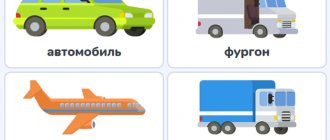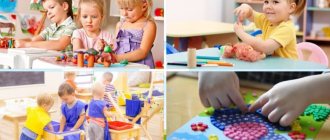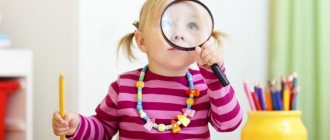- Why does a preschooler need to solve logic problems?
- Rules for solving logic problems for preschoolers
- Logic problems, assignments and games for preschoolers
Task for developing intelligence (for children aged 6, 7 years)
- Tasks for the development of creative abilities
- Logic problems - tests with answers
- Logic problems “Crossings and maneuvers”
- Entertaining tasks to develop logical thinking in preschoolers
The main and important point in the development of a preschooler is the formation of his logical thinking (this is precisely why it is necessary to solve logical problems!). Thanks to logic, you can explain life phenomena to a 5-6-7 year old child and justify your point of view. If you develop the ability to think and act logically in time, the child will definitely become a sane person.
To achieve this goal, parents and educators use various exciting and interesting games, create game situations of a logical nature, which makes classes not only interesting, but also very useful for small pets, as they are aimed at developing intelligence and thinking. Such tasks and games will force the little brain to reason, taking into account, first of all, logic.
We all know that children love to think, trying to show that they are adults. Yes, any adult will notice errors in reasoning, which are associated with an inaccurate logical structure of thought. The child very often reasons correctly and is close to the answer, but due to his lack of logic, it is difficult for him to explain or express his point of view. Adults will help him overcome this obstacle, and in this they will need logic games and tasks (tasks). When the baby finally gains the ability to think logically, he will easily be able to solve simple and complex problems that life will set for him.
Preschool children really like logic puzzles. They are interested in reasoning and flexing their brains. Many children, after reading a logical task, immediately give the correct answer, but not everyone can explain the course of their thoughts. Then the teacher or parent should help the student build a chain of thoughts using the correct methodology for working on tasks with a logical load.
Rules for solving logic problems for preschoolers
1. Spend up to 10 minutes exercising several times a week;
2. During the explanation, it is advisable to use visual materials (drawings, diagrams, tables);
3. Give the child a few minutes for his own reasoning, mandatory collective discussion, exchange of opinions;
4. You don’t have to write down tasks in your notebook;
5. When analyzing a logical problem, it is necessary to pay attention to the initiative and perseverance of students, help them find the answer thanks to correctly posed questions, and also explain beautiful and original solutions;
6. If the task turns out to be difficult, it is advisable to think at home.
Below are logic problems that are constantly used by teachers in their work, and most importantly, preschoolers readily solve them.
Fourth wheel
Ask your child what is unnecessary, then ask them to justify it. For example:
- sundress, shirt, boots, fur coat (boots - shoes);
- cabbage, plum, eggplant, beet (plum is a fruit);
- pig, wolf, fox, deer (pig is a domestic animal);
- chest of drawers, cabinet, wardrobe, sofa (sofa - upholstered furniture).
In this case, more complex categories are again used than at the previous stage, since the child must know more about the world around him.
Logical tasks and games for preschoolers
Task for developing intelligence (for children aged 6, 7 years)
Among logic games, games for developing ingenuity occupy a significant place. They are lively, interesting, and you can learn a lot of new things from them. Such games allow the child to quickly switch from one activity to another, which helps develop logic. Games of wits help students win by showing their peers what they are capable of. Lazy kids, looking at the victory of others, should try to manifest themselves through trial and error, force themselves to think. Thus, logic games for developing ingenuity are very useful for the overall development of children. Examples of such games.
Game "That's how I am!"
Children form a circle. The presenter points to one of the students and says: “That’s how I am!” After this command, the student begins counting and the players count one by one, but earlier the leader said that instead of some numbers it is necessary to say “That’s how I am!” Such numbers can be numbers that contain the number 6, or numbers divisible by 2, etc. (for example: 1, 2, 3, 4, 5, “that’s how I am,” 7, 8, etc. ). You need to play fast. If a player gets lost, he leaves the game. The counting starts all over again. One player must remain.
Tasks for the development of creative abilities
Unfortunately, very often parents believe that it is impossible to develop logical thinking in a child, since he should have such abilities from birth. This is a wrong assumption. You should look closely at your baby, find hidden talents, and develop these talents from an early age. But in order to better achieve this goal, the child needs to create comfort and a good atmosphere.
Psychologists offer many games for developing creative abilities, in particular coloring books and exercises with completing pictures.
Game “Complete the picture”
Concept of logical thinking
Logical thinking is a physiological process as a result of which a person comes to conclusions based on evidence and prudence.
There are three types of logical judgments.
- Abstract judgment. A person builds conjectures on concepts and properties that cannot be felt. They are not valid, they are in the abstraction.
- Figurative judgment. A person uses his imagination and imagines specific images that occur in life.
- Verbal judgment. People often share their opinions with others. During the conversation, mental analysis occurs, leading to specific conclusions.
Logical thinking begins to develop at an early age. The stages of formation of thinking in the process of child growth will be discussed further.
Assignments - tests (with answers) for children from 5 years old
Logical tasks also include tasks - tests. These tests contain one correct answer.
Task 1. Kolya, Anya and Nastya went into the forest and found 4 mushrooms. How many mushrooms would the children find if only Kolya and Anechka left?
a) 0; b) 1; at 2; d) 3; e) 4. (Correct answer.)
Solution. The number of mushrooms does not depend on the number of children who found them.
Problem 2. Alice had 3 ribbons. One of them was torn in half. How many ribbons does the girl have now?
a) 1; b) 3; at 4; (Correct answer.) d) 5.
Solution. Alice has two whole ribbons, and from one torn one two were formed. That is, the girl now has: 2 + 2 = 4 ribbons.
Task 3. Kostya wrote OLYA MALA on a piece of paper and went to the mirror. What phrase can you see in the mirror?
a) Olya small; b) SMALL OLIA; c) ALAM YALO; (correct answer.) d YALO ALAM.
Solution. Since all the letters of the written words are symmetrical, they will remain the same letters in the mirror. But they are located in the opposite direction. That is, two words are formed, written from the end. Experiment with paper in front of a mirror.
Problem 4. 8 children were playing in the yard. When mom called for lunch, Mariyka, Dima, Seryozha, Timofey, Uncle Nikolai and Grandfather Nikolai came running to the table from the yard. How many children are left playing in the yard?
a) 2; b) 3; at 5; d) 4. (Correct answer.)
Solution. Among all those who came running to their mother’s call, the children are Masha, Dima, Seryozha and Timofey, that is, four children came running. There are 8 – 4 = 4 children left to play in the yard.
Logic problems “Crossings and maneuvers”
Interesting logic problems are logical crossing problems and maneuvers. These exercises focus on difficult situations involving the crossing of animals or objects. It is necessary to come up with some way or algorithm to do this. They are usually called maneuvers. In crossing tasks, you need to transport something or someone or change places, observing some rules.
Problem 1. Two hungry dragons are resting on the left bank of the stream, and a defenseless kitten Vasya is sitting on the right bank of the stream. The Lord of the Dragons, Uncle Mitya, plies between the banks on his longboat. It is forbidden to leave a dragon and a kitten unattended on one of the banks, and more than one animal cannot be placed on a longboat. How can Uncle Mitya transport the dragons to the right bank and the kitten to the left?
Clue. First of all, the Lord of the Dragons, Uncle Mitya, must take one of the dragons with him.
Solution. To solve the problem, the lord of the dragons really first needs to take one of the dragons with him to the opposite shore, but there is a defenseless kitten sitting on the shore, therefore, having transported the dragon, Mitya will have to take the kitten with him to the opposite shore, on which there is still one dragon left. Uncle Mitya will take this dragon that remains with him and transport it to the right bank, and leave the kitten on the left bank. Thus, the lord of the dragons, Uncle Mitya, will transport the kitten to the left bank and the dragons to the right in three swims.
Problem 2. Two travelers approached the river. On the river bank a boat was found that could carry only one person. However, they were able to cross the river and continue their journey. How could this be?
Clue. Maybe they weren't walking together?
Solution. This is possible if they approached the river from different banks. Then the first crossed to the shore of the second, and the second to the shore of the first.
Task 3. The simplest maneuver exercise is to place three balls in the opposite direction. You can only change two adjacent ones.
The solution is very simple - change the balls one by one until you hold the desired one.
The proposed logic tasks are a good way to develop mathematical thinking and increase the activity of thought. With constant use of these, you can get high positive results in the development of logical thinking.
Logic problems for older preschool children
Valentina Rozhkova
Logic problems for older preschool children
September. 1 year of study.
Week 1: - Think and decide: Who will swim to the shore faster - a duck or chickens?
— What is the best and fastest way to pick a watermelon from a tree? (watermelon does not grow on a tree)
.
2nd week:
— There were children's books on the shelf. The dog ran up, took one book, then another, then two more. How many books will she read? (Not at all. Dogs can't read)
— There are 3 branches on the oak tree, on each branch there are 3 apples. How many apples are there in total? (Apples do not grow on oak trees.)
3rd week:
- Who will reach the flower faster - a butterfly or a caterpillar?
— There were 3 carrots and 4 apples in the plate. How many fruits were in the plate? (4 apples. Carrots are not a fruit, but a vegetable)
-The cat Murka gave birth to puppies: one black and two white. How many puppies does Murka have? (None. The cat has kittens.)
Week 4: - Who is the eldest ? Who's the shortest? Who is taller - father or mother? Who is older than you ? Who is taller than you, but shorter than mom?
— Three sparrows sat on the water. One flew away. How much is left? (sparrows do not sit on water)
.
— A multi-colored wheel is rolling: one corner is red, the other is green, the third is yellow. When the wheel reaches the edge of the table, what color will be visible? (None. The wheel has no corners)
October. 1st year of study.
1st week.
— On the shelf were: a pyramid, a tumbler, a teapot and a doll. How many toys are on the shelf? (Three. A teapot is a tableware)
.
- How many ends does a stick have? Two sticks?
2nd week:
— A rooster and a hen were walking around the yard. A rooster has two legs, and a chicken has four.
How many feet were walking around the yard? (-The chicken has 2 legs, not four)
.
— How many chickens did the rooster hatch if he laid 5 eggs?
(Not at all. Roosters don't lay eggs)
- Who will moo louder - a rooster or a cow? (Roosters don't moo)
3rd week:
— Marina and Tanya drank different juices - apple and grape. Marina did not drink apple juice. What juice did Tanya drink?
— Katya and Lena painted with paints and pencils. Katya did not draw with paints. What did Lena draw with?
— Mom has a cat Fluff, a daughter Dasha and a dog Sharik. How many children does mom have ?
4th week:
— Kostya and Artem were dressed in jackets of different colors: blue and green. Kostya was not wearing a blue jacket. What color jacket was Artem wearing?
— One banana falls from the tree every minute. How many of them will fall in 5 minutes?
November. 1st year of study.
1st week.
— How to use two sticks to form a square on the table?
- Grandma has a granddaughter Masha, a cat Fluff, and a dog Druzhok. How many grandchildren does grandma have?
2nd week:
— How to form a triangle on the table using only one stick?
— The cat Vaska and his owner are sitting in a boat. The owner throws out a fishing rod and says: “Catch, fish, big - very big.”
.And Vaska quietly mutters:
“Little catch, little one
. Why did he say that?
3rd week:
- I bought it for one ruble, paid two rubles. How much change will they give?
— Ping the penguin felt cold and jumped up 6 times to warm up. His brother Gwin also decided to warm up and jumped 4 times. Who was colder: Pin or Gwin?
4th week:
- You, me, you and me. How many of us are there?
Entertaining tasks to develop logical thinking in preschoolers
A lot of tasks and logic games, as well as puzzles for children from 4 to 7 years old, can be found in the manual by Z.A. Mikhailova "Entertaining tasks for preschoolers."
The manual contains tasks, games, and puzzles for working with children aged 4-7 years. The material is presented in a certain system, which is important for increasing the level of general mental development of children, preparing them for mastering a mathematics course at school, and for creative work in the future.
An example of a logical problem from a book to find a pattern:
Problem with sticks (matches):
Download the manual in pdf format for free
Thinking in children's lives
When a child approaches the age of 5-6 years, parents should pay attention to the level of his thinking. Because the ability to analyze and systematize the information received will improve school performance. Games with geometric shapes help systematize knowledge about the concepts: shape, color and size.
Is it possible to carry a bulky wardrobe along a narrow corridor? What to sew, what to wear to prom? How to stand in such a way that each person is clearly visible in the resulting photograph? All these tasks are set for imaginative thinking. The images themselves come in several categories depending on which sense organs are perceived.
Concepts are also included in the category of thinking and together represent irreplaceable elements. With the help of images, you can very quickly make a decision about the production and arrangement of this object. Of course, it is necessary to have the internal ability to manipulate images (mentally rotate objects), transform them and combine them. This kind of thinking is vital, but it doesn’t happen right away.
Small children should not cross the street alone, as they are not yet able to correctly assess the correct distance between them and the car. Such an ability will be formed only by the age of 15. The received information about images is perceived instantly, in a few milliseconds.
Retelling what you saw or read will take much longer than the fleeting run of a cat, and, moreover, it will not always be complete, because for many phenomena there are simply no suitable names or words. Those properties of an object that are reflected in images can be placed within a narrow conceptual framework. They cannot be divided into essential and non-essential. This ability of images is very valuable when solving problems.
With the help of figurative thinking, you can see various properties of an object (including those that are usually considered unimportant in concepts) and, already using these properties, identify connections between objects.
At the end of the 20th century, photography, film, and television significantly simplified the creation and transformation of images compared to traditional drawing techniques. Now it has become much easier to clearly show the subject under discussion, show the dynamics of change, and identify various possible outcomes of an event. This greatly helps to carry out quality work, making a person’s life easier.
To solve assigned problems, a person uses certain algorithms and action patterns. These algorithms are composed of both images and concepts. Operating with formal knowledge, a person projects new, unique images in his mind that will help him in the future to cope with tasks faster. Therefore, for high-quality activity it is necessary both to think in images and to operate with concepts that have long been known to everyone.
Logic tasks to test the readiness of a 6-7 year old child for school
An excellent collection of logical tasks for preschoolers, developed taking into account the Federal State Educational Standard. In total, this book has five sections with logical tasks - comparison, classification, patterns, spatial thinking, and inference. Each section contains 7-11 exercises, which are best performed in the order in which they are given in the collection.
Download a collection of tests and logic problems for preschoolers in pdf format
Logic for children 5 - 7 years old
This manual contains very interesting tasks, assignments, exercises and games for the development of logical thinking in preschool children, aimed at comparing objects according to various criteria, highlighting significant differences between objects, generalization and classification. This book is recommended for use in kindergartens and at home for children to study together with their parents. This manual can be used to prepare for mathematics lessons at school.
Download the manual by Tikhomirova L.F. Logics. Children 5-7 years old in pdf format
Finding errors and inconsistencies
These tasks are an excellent tool for training attention and it is not important that the child learns not to immediately take the information received on faith, but to think for a while.
For such tasks, you can use fable pictures (for non-speakers) or in the form of fable poems, for example:
- Sasha ate soup, so he is hungry;
- Ilona couldn’t come home, so she forgot her keys, etc.
By the way, such tasks are very useful for correcting agrammatisms and developing a full understanding of speech.






